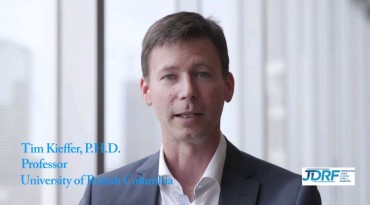New Details Emerge from JDRF-Supported Islet Cell Encapsulation Research during 2015 American Diabetes Association (ADA) Scientific Sessions
Cell sources and encapsulation materials are highlighted
JDRF-supported researcher Timothy Kieffer talks about the 2015 ADA conference.
JDRF’s work to accelerate development of encapsulated islet cell therapies for treatment of type 1 diabetes (T1D) was on display at this year’s ADA conference as three investigators funded by the organization presented new details from their recently published works.
The presentations took place during a session covering next-generation encapsulation research. Two focused on work being done by Timothy Kieffer, Ph.D., at the University of British Columbia and Douglas Melton, Ph.D., of Harvard University to create techniques for accelerating the development of human stem cells into insulin-producing islets for use in encapsulated cell therapies. The third presentation focused on efforts by Massachusetts Institute of Technology (MIT) researchers Daniel Anderson, Sc.D., and Robert Langer, Ph.D., to develop encapsulation materials that can protect islets from an immune system attack once they are implanted.
Dr. Kieffer has developed a seven-step protocol that rapidly converts human embryonic stem cells into mature islets with the ability to produce insulin before implantation. The process currently used by some investigators to create these cells takes weeks longer, and they must be implanted in order to complete their maturation into insulin-producing islets. During his ADA presentation, Dr. Kieffer revealed that the islets he developed reversed diabetes in mice four-times faster than cells created using the current four-step process. If successfully translated for human use, Dr. Kieffer’s protocol could provide a consistent cell source for islet cell implants and shorten the time in which recipients would begin to benefit from their implants. The technique also could be used to produce large numbers of islet cells for research purposes.
Dr. Melton’s research showed that the multi-staged protocol he has developed is capable of converting human stem cells into insulin-producing islets in roughly six weeks while still in the lab. By comparison, previously established methods require a total 20 to 24 weeks—which includes maturation time after implantation—to create insulin-producing islets. How well these and other converted cell sources will work and how much insulin they will produce is a key question that still needs to be answered. Melton revealed to ADA attendees that early work shows his method creates islets that produce approximately the same amount of insulin as beta cells found in a healthy pancreas.
While the progress is encouraging, Dr. Melton acknowledged that his lab still needs to address a number of challenges in order produce reliable, high-quality islets. One challenge is that in some cases, cells within a cluster get stuck and don’t fully develop. Investigators are working to understand how this hitch would impact the therapeutic effect of an islet cell implant. They also are looking to develop a protocol for rapidly developing islet cells that produce other hormones, such as glucagon, which also helps with blood-sugar management.
Dr. Anderson of MIT told ADA attendees that his team has identified a number of potential encapsulation materials that caused little to no immune system reaction in animal studies, and they are currently working with Dr. Melton’s lab to design novel experimental therapies. This project—funded by JDRF and The Leona M. and Harry S. Helmsley Charitable Trust—is currently testing potential encapsulated islet cell implants in small and large animal models.
